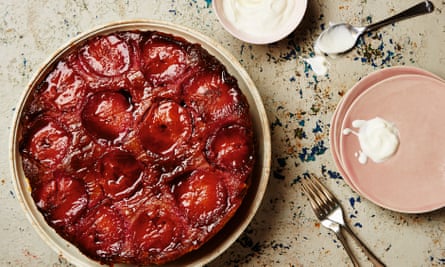I love duck, any kind of duck – that rich, gamey flavour is unlike any other meat. I roast smaller wild duck whole, but rarely do the same to larger, farmed ones; their fat breasts are best flash-fried, so they’re caramelised on the outside and pink and juicy in the middle (they also stretch much further when cut into very thin slivers); the thighs, meanwhile, are best braised slowly until almost falling off the bone. I can’t see why anyone would cook the two together, so here’s a lovely way to cook the breasts; I’ll do a thigh recipe in the next few weeks.
Armenian figgy duck with spiced walnut pilaf
The soft, sweet spices here are like a comfort blanket, perfect for the coming autumn. Serves four to six.
For the pilaf
3 cloves
½ tsp black peppercorns
½ tsp ground allspice
¼ nutmeg, grated
40g butter
1 large red onion, peeled, cut in half and finely sliced
Sea salt and freshly ground black pepper
1 cinnamon stick
75g walnuts, roughly chopped
300g basmati rice, soaked in water for 30 minutes
For the duck
3 duck breasts, skin scored
25g butter
6 figs, cut in half lengthways
1½ tbsp sherry vinegar
To serve
1 large handful each chopped parsley and dill
1 lemon
Turkish chilli flakes, optional
Grind the cloves and peppercorns to a fine powder in a mortar or spice grinder, then mix with the allspice and nutmeg. Melt the butter in a large casserole on a medium heat, then fry the onions with half a teaspoon of sea salt until soft, about 10 minutes. Add the ground spices and walnuts, and cook for three minutes, until fragrant.
Boil the kettle. Stir the drained rice into the onions, to coat it in butter and spices, then add enough boiling water to cover by two fingers. Leave to simmer gently for 20 minutes, then cover and transfer to the oven, heated to its lowest setting, to finish cooking in its own steam. It can rest for up to an hour.
Put a heavy frying pan on a high heat. Generously season the duck, add half the butter to the pan and lay in the breasts skin-side down. Turn down the heat to medium-high and fry for about five minutes, until the skin is golden and the fat has started to render out. Pour off any excess fat, turn over the breasts, cook for a couple of minutes more, then lift from the pan, cover with foil and rest in the oven.
Pour the fat out of the pan, wipe it clean, then return to the heat. Add the rest of the butter and, once it begins to sizzle, add the figs cut side down. Season lightly and cook for a couple of minutes, until starting to caramelise; crush a few fig halfs with the back of a spoon, to help thicken the sauce. Add the vinegar and 50ml water, simmer to reduce to a syrupy, glossy sauce, then season to taste; add a pinch of sugar, if needed.
Fluff up the pilaf with a fork and cut the duck into as thin slices as possible. Add any resting juices to the fig sauce. Serve the duck with the rice and sauce, sprinkling over the herbs, lemon and chilli flakes, if using.
Flourless plum and vanilla upside-down cake

This cake is inspired by Claire Ptak, who cooked the most delicious flourless muffins at the Port Eliot festival in Cornwall earlier this summer. You can buy ready-made almond paste online, if you fancy a shortcut, but make sure it contains at least 60% almonds. Serves 10.
250g butter, at room temperature, plus extra for greasing
300g skin-on almonds
300g caster sugar, divided
3 eggs
Zest of 1 orange
1 tsp vanilla extract
2 tsp baking powder
½ tsp salt
225g polenta flour
75g light brown sugar
550g plums, stoned and halved
Heat the oven to 175C/gas mark 3½. Grease and line the base of a loose-bottomed 23cm cake tin.
Put the almonds in a food processor and grind for at least five minutes, until you see some oil coming out of them. Add two-thirds of the caster sugar and carry on grinding for a few minutes, until you have a paste. Clean everything down and set the paste aside.
In the bowl of a food mixer, beat the butter until pale, light and fluffy, then add the remaining caster sugar and beat for a few minutes to combine. Beat in the eggs, one at a time, followed by the orange zest, vanilla extract and 440g of the almond paste. Once thoroughly combined, gently beat in the baking powder, salt and polenta flour.
Sprinkle brown sugar around the inside of the greased tin and lay the plums cut side down on the base. Pour over the cake mixture and smooth with a spatula. Put the cake tin on a baking tray, cover with baking paper and bake for about an hour, until a skewer comes out clean.
Leave the cake to rest in the tin for 20 minutes, then run a knife around the edge to loosen. Put a large plate on top and invert the cake on to the plate. Remove the tin and replace any dislodged pieces of fruit. The cake is lovely with cream or creme fraiche.
And for the rest of the week…
Leftover strips of duck and cold rice makes a sensational filling for a lunchbox. Or put the meat between bread with chutney, mayo and piles of rocket for a superior sandwich. Or ditch the bread and make a duck and rocket salad with a sweetish dressing (raspberry vinegar would work well). The almond paste for the cake freezes beautifully, so make double the amount and stash for next time you fancy an almondy treat.

Comments (…)
Sign in or create your Guardian account to join the discussion